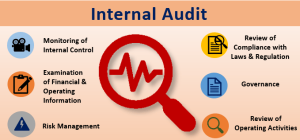What is Internal Audit , Different Types, and the 5 Cs ?
Internal audits evaluate a company’s internal controls, including its corporate governance and accounting processes. These types of audits ensure compliance with laws and regulations and help to maintain accurate and timely financial reporting and data collection. Internal auditors are hired by companies who work on behalf of their management teams. These audits also provide management with the tools necessary to attain operational efficiency by identifying problems and correcting lapses before they are discovered in an external audit.
tasked with providing independent and objective evaluations of company financial and operational business activities. They are employed to ensure that companies follow proper procedures and function efficiently.
Purpose of internal audit :
The purpose of internal audit is to confirm that the practical implementation
complies with the accrediting standard, the management system requirements, and
other requirements such as local, state, federal, and international laws, etc. The primary goal of the audit is to generate a judgment about the data in the report as
a whole, not to find every possible inconsistency. This translates to the fact that, despite the fact that auditors keep an eye out for any indications of potential material fraud, it is impossible to guarantee that frauds will be found.
Types of internal audit:
• Financial/controls audits
• Compliance audits
• Operational audits
• Construction audits
• Integrated audits
• Information systems audits
• Special investigations
• Follow-up audits and validation testing
Internal Audit Reports: The 5 C’s
Internal audit reports are often known for adhering to the 5 C’s reporting requirement. A complete, sufficient internal audit often ends with a summary report that communicates answers to the following questions:
- Criteria: What particular issue was identified, and why was the internal audit necessary? Is the internal audit in preparation for a future external audit? Who requested the audit, and why did this party request the audit?
- Condition: How as the issue in relation to a company target or expectation? Does the company have a policy that was broken, a benchmark that was not met, or other condition that was not satisfied? Is the company confident no issue exists, or do they believe an issue is at hand?
- Cause: Why did the issue arise? Who was involved, what processes were broken, and how could the issue have been avoided?
- Consequence: What is the outcome of the problem? Are issues limited to internal matters, or are there risks of external consequences? What is the financial implications of the issue?
- Corrective Action: What can the company do fix the problem? What specific steps will management take to resolve the issue, and what type of monitoring or review will occur after solutions have been put in place to ensure a fix has been implemented.
Code of conduct for auditor :
Impartiality:
Evaluate impartiality toward the conformity/inspection/certification, to be
assessed, and inform the organization on which behalf audit is being conducted.
Confidentiality:
Keep information about assessed organization strictly confidential.
Loyalty:
Auditor must remain loyal to the organization utilizing the services and must
avoid about any consultancy to the auditee.
Positive:
Auditor must keep positive and professional attitude during the audit.
Finally, Audit/Assessment is important in monitoring the effectiveness of the implementation of the standard or some specific requirements in the organization/laboratory/
inspection/certification body/quality management system. Both external and internal
audits yield useful information; however, internal audit is the major and detailed
activity having a complete overview of all activities with ample time. Audits are used
to identify problems in the organization, in order to improve processes and procedures. An outcome of audit/assessment is lead toward the improvement by finding
root causes of problems and taking corrective actions
REF:
Six Sigma and Quality Management-Intech open-2022
ALICIA TUOVILA-internal audit-2022
Kristensen and Kanji – Purpose of internal audit – 2002







